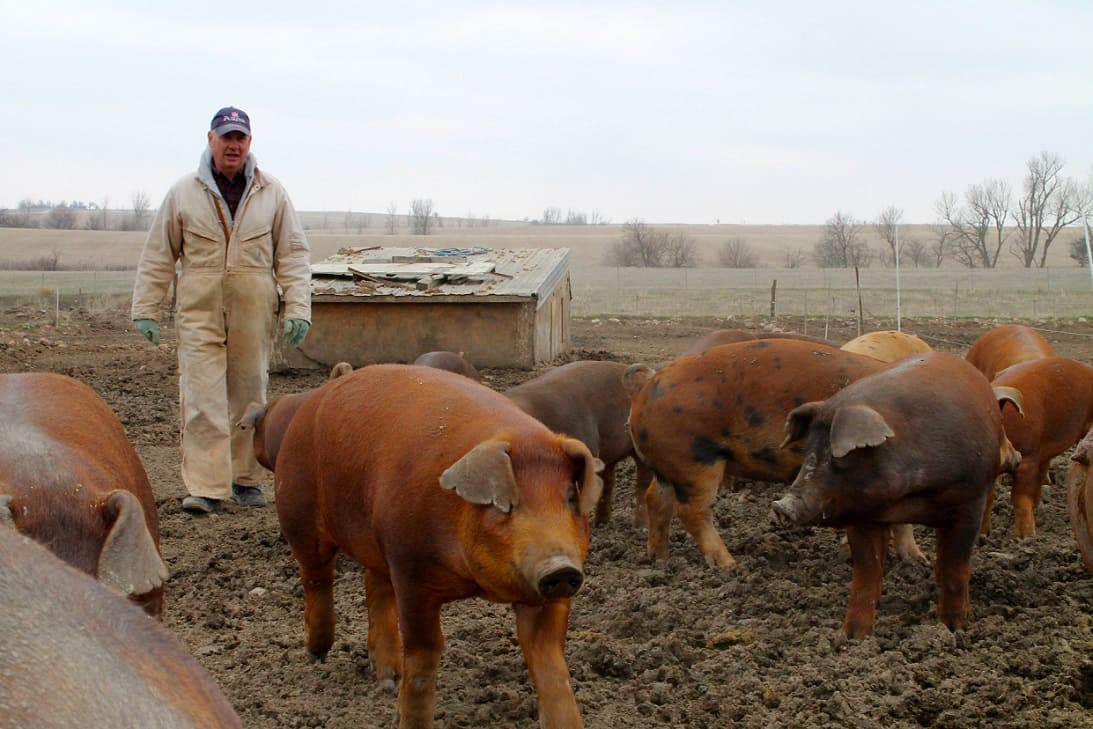Picture this: you’re at a farm-to-table restaurant, and the server proudly announces that tonight’s pork chop comes from heritage Duroc pigs. The meat arrives beautifully marbled, incredibly tender, and bursting with flavor that makes you wonder why every pork chop doesn’t taste this good.
That’s the magic of the Duroc pig—a breed that has quietly revolutionized American pork production while maintaining its status as the gold standard for meat quality.
I still remember my first encounter with Duroc pigs during a visit to a family farm in Iowa. The farmer, weathered hands gesturing enthusiastically, explained how these reddish-brown pigs had transformed his operation. “They’re not just pigs,” he said, “they’re profit with personality.”
That conversation sparked a deep appreciation for this remarkable American breed that deserves far more recognition than it typically receives.
A Horse, A Boar, and American Innovation: The Duroc Origin Story
The Duroc pig’s origin reads like a classic American tale of ingenuity and serendipity. In 1823, in the rolling hills of Saratoga County, New York, a farmer named Isaac Frink made a decision that would shape the future of American pork production.
While visiting Harry Kelsey’s farm to admire a famous trotting stallion named Duroc, Frink spotted some red pigs that caught his eye.
These weren’t just any pigs—they possessed a combination of size, temperament, and quality that impressed the experienced farmer. Frink purchased several of these red pigs and, in honor of Kelsey’s celebrated stallion, named them Durocs. What started as a whimsical naming choice became the foundation of one of America’s most successful pig breeds.
The modern Duroc emerged from the strategic blending of two distinct regional strains: the massive Jersey Reds from New Jersey and the more compact, refined Durocs from New York. The Jersey Reds were impressive for their enormous size and prolific nature, reaching weights that amazed farmers of the era.
However, they lacked the meat quality and manageable disposition that practical farmers truly needed. The New York Durocs, while smaller, offered superior carcass quality, finer bone structure, and a calmer temperament that made daily management much easier.
This cross-regional breeding program, which gained serious momentum in the 1860s, represented American agricultural innovation at its finest.
The systematic blending created something truly special—a pig that combined the best traits of both lines while eliminating many of their weaknesses. It was perfectly suited to the expanding Corn Belt, where corn-rich diets would help these pigs reach their genetic potential.
The breed gained national recognition at the 1893 Chicago World’s Fair, where the first successful Duroc hog show introduced these remarkable pigs to farmers across America. This exposure sparked a popularity that continues today, making Durocs the second most recorded breed of swine in the United States.
What Makes a Duroc Special: Beyond the Red Coat
Walk into any pig barn where Durocs are kept, and you’ll immediately understand why farmers fall in love with this breed. Their distinctive coloring is the first thing you notice, but it’s far from the only impressive characteristic.
The Signature Look
Duroc coloring ranges from light golden yellow—almost like a pale honey—to deep, rich mahogany that approaches the color of fine furniture. This solid red coloring serves a practical purpose beyond aesthetics.
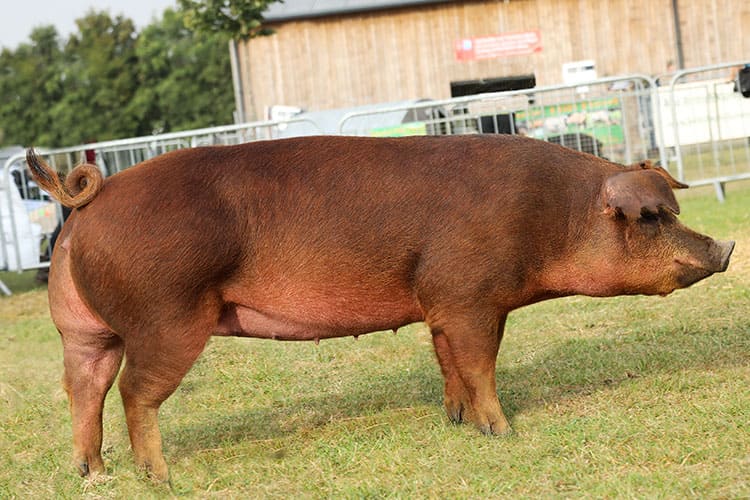
Unlike breeds with white markings or pink skin, Durocs’ dark pigmentation provides natural protection against sunburn, making them ideal for outdoor production systems.
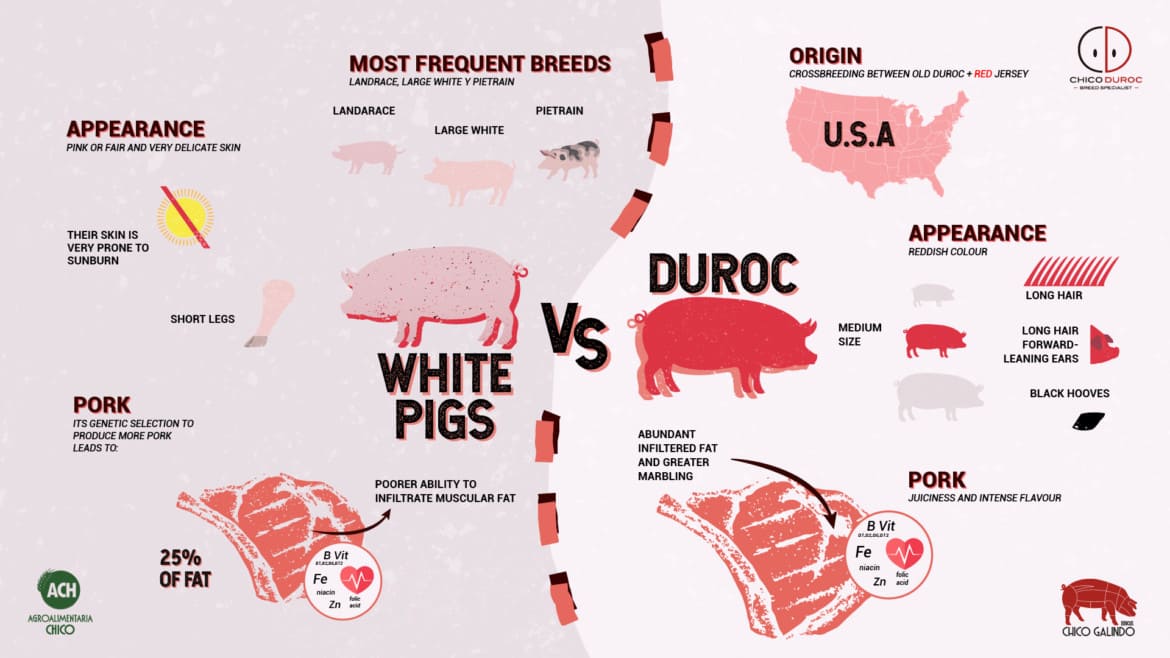
Their physical structure tells the story of centuries of selective breeding. These are substantial pigs with purpose-built frames: mature boars typically weigh around 880 pounds, while sows reach approximately 770 pounds.
They feature moderately long bodies with exceptional muscle development, particularly in the ham and shoulder areas that translate directly to premium cuts of meat. Their characteristic drooping ears (never erect) and slightly dished faces give them an almost gentle expression that reflects their generally calm nature.
Beyond Size: The Duroc Advantage
What truly sets Durocs apart goes far deeper than appearance. Their exceptional feed conversion efficiency means they can transform smaller amounts of feed into larger amounts of high-quality muscle mass. In an industry where feed costs represent up to 70% of production expenses, this translates to significant economic advantages.
Here’s How to Reduce Hay Loss: Best Storage & Feeding Practices for Farmers
Their adaptability is legendary among pig farmers. I once visited operations in both scorching Texas heat and bitter Minnesota winters where Durocs thrived equally well.
In winter, they develop thick, insulating coats that molt naturally in summer, leaving them comfortable in hot weather. This adaptability eliminates the need for expensive climate-controlled facilities that many modern breeds require.
The Science Behind Superior Meat: Why Chefs Choose Duroc
When top chefs specifically request Duroc pork, they’re making a decision based on measurable meat quality differences. The secret lies in intramuscular fat distribution—the marbling that makes meat tender, juicy, and flavorful.
Modern pig breeding has focused heavily on producing lean meat, often at the expense of eating quality. Durocs naturally excel at depositing intramuscular fat throughout their muscle tissue in precisely the right amounts and locations.
This isn’t just random fat—it’s strategically placed marbling that melts during cooking, basting the meat from the inside and creating that melt-in-your-mouth texture that distinguishes premium pork.
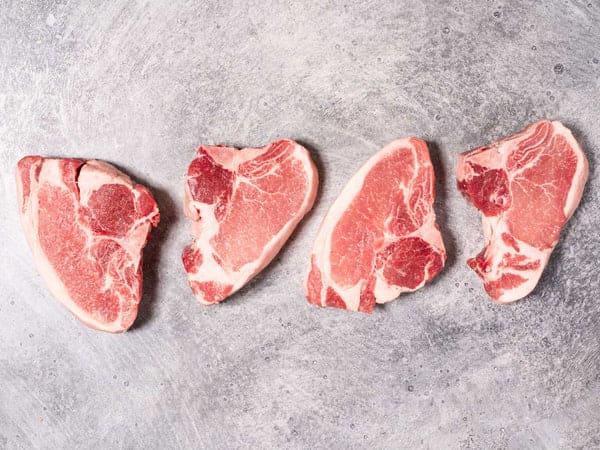
Research consistently demonstrates Duroc superiority in eating quality. Studies show Duroc pork typically contains 2.5-3% intramuscular fat compared to 1.5-2% in commercial breeds.
The meat exhibits better color (a darker, more appealing pink), reduced cooking losses, and enhanced flavor profiles. In controlled taste tests, consumers consistently rate Duroc pork higher for juiciness, tenderness, and overall acceptability.
The difference is so pronounced that premium pork producers worldwide specifically seek out Duroc genetics. In European markets, where consumers pay premium prices for superior pork, Duroc genetics command significant price premiums.
Asian markets, particularly Japan and South Korea, where marbling is highly prized, often require intramuscular fat levels above 5%—a standard that Durocs can achieve naturally.
Breeding Excellence: Understanding Duroc Standards and Genetics
For those interested in breeding Durocs, understanding the breed standards and genetic principles is crucial for success.
Official Breed Requirements
The United Duroc Swine Registry maintains specific standards that define breed eligibility.
Breeding animals must possess six or more functional teats on each side, maintain the characteristic red coloring without white or black hair, and demonstrate stress-negative genetics.
The breed cannot have more than three black spots on the skin, none larger than two inches in diameter.

Genetic Performance
Modern Durocs demonstrate impressive genetic trends. Average daily gain has improved by approximately 4.5 grams per day annually through systematic selection, while backfat thickness has decreased by 0.22 millimeters per year.
These improvements mean today’s Durocs grow faster and leaner than their predecessors while maintaining their meat quality advantages.
Crossbreeding Strategies
Understanding crossbreeding percentages is essential for commercial success.
Research shows that 50% Duroc crosses often provide optimal balance between maternal ability and meat quality, while 100% Duroc genetics maximize eating quality but may reduce reproductive performance.
Many successful operations use 25% Duroc in their maternal lines to improve robustness and longevity.
The Terminal Sire Revolution: Durocs in Modern Agriculture
Understanding the Duroc’s role as a “terminal sire” reveals their massive impact on modern pork production. This technical term describes male breeding animals used specifically to produce market pigs rather than breeding replacements.
Here’s how this system maximizes efficiency: commercial producers use highly prolific maternal breeds like Yorkshire and Landrace for breeding sows. These breeds excel at producing large litters (often 10-12 piglets) and providing excellent maternal care. When it’s time to produce pigs for market, farmers cross these maternal lines with Duroc boars.
This creates an ideal combination: offspring inherit the prolific nature and maternal ability of their mothers while gaining the superior growth rates, feed efficiency, and meat quality of their Duroc fathers. The result is market pigs that grow faster, convert feed more efficiently, and produce higher-quality carcasses than either parent breed alone.
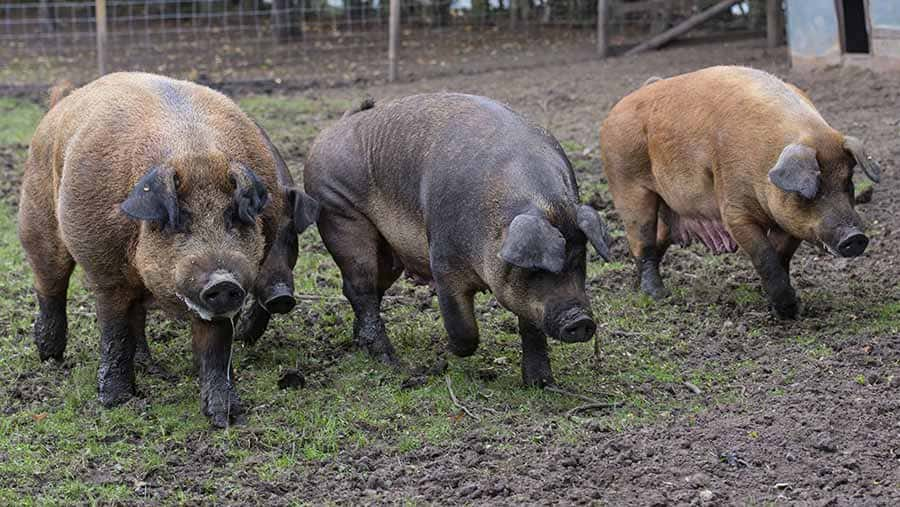
The economic impact is substantial. Duroc-sired pigs typically show 10-15% better feed conversion ratios and produce carcasses with 60-65% lean meat while maintaining the marbling that creates superior eating quality. This combination of efficiency and quality creates value throughout the production chain.
International Impact: Durocs Around the World
While born in America, Durocs have become a global phenomenon. They’re now the second most recorded breed worldwide and play crucial roles in pork production across multiple continents.
In Europe, Durocs are prized for their ability to produce high-quality pork in outdoor systems. British producers particularly value their hardiness and ability to thrive in variable weather conditions. Danish breeding programs have developed specialized Duroc lines that achieve exceptional feed efficiency while maintaining meat quality.
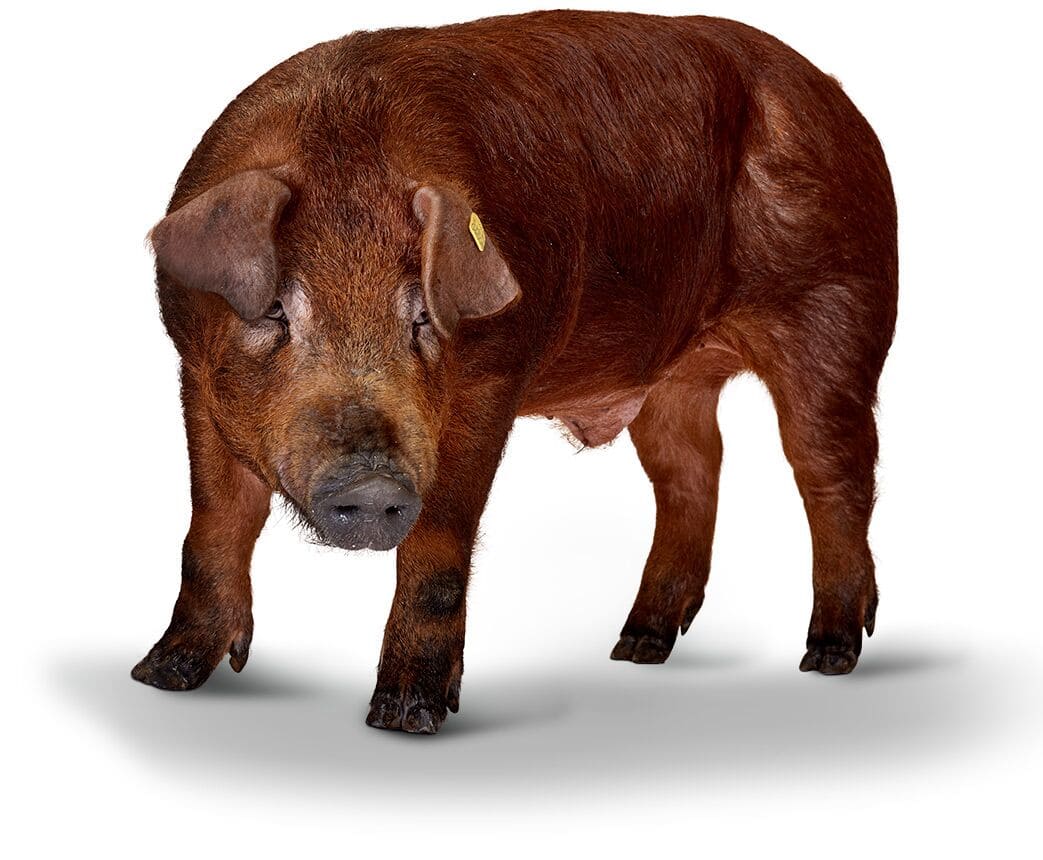
Asian markets represent growing opportunities for Duroc genetics. Countries like South Korea and Japan, where consumers demand high levels of marbling, increasingly incorporate Duroc genetics to meet these quality standards. Chinese producers, facing growing domestic demand for premium pork, are investing heavily in Duroc breeding programs.
Practical Management: Raising Durocs Successfully
Success with Durocs requires understanding their specific management needs and optimizing systems to leverage their natural advantages.
Housing and Environment
Durocs adapt well to both confined and outdoor systems, but their management requirements differ slightly from other breeds. Their larger size requires adequate space—allow at least 8 square feet per pig in finishing facilities. Their social nature means they perform best in groups, but their size requires sturdy fencing and facilities.
For outdoor systems, Durocs are nearly ideal. Their dark skin provides sun protection, their hardy constitution handles weather variations, and their foraging ability can reduce feed costs. However, provide adequate shade and wallows for hot weather, and ensure windbreaks are available during cold periods.
Nutrition Strategies
Durocs respond exceptionally well to quality nutrition programs. Their efficient feed conversion means investment in good feed programs pays dividends through improved performance. Focus on energy-dense diets during the growing phase to maximize their genetic potential for rapid gain.
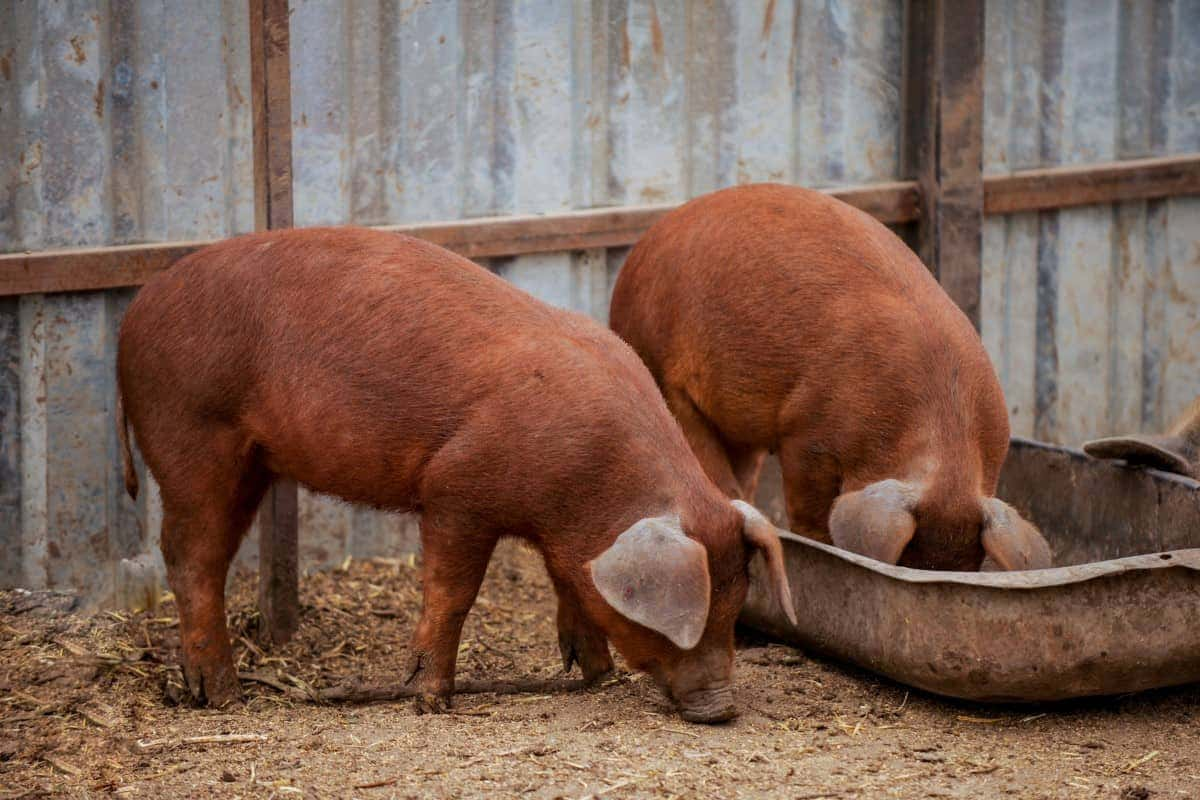
During finishing, consider strategies that enhance marbling development. Some producers use specialized feeding programs that increase energy density during the final weeks before slaughter, enhancing intramuscular fat development without excessive backfat.
Health Considerations
Modern Durocs are generally hardy and disease-resistant, but some intensive selection programs have created health challenges. Choose breeding stock from lines that maintain good structural soundness and avoid animals showing signs of stress susceptibility or aggressive behavior.
Preventive health programs are essential. Maintain vaccination schedules appropriate for your area, provide clean water and adequate ventilation, and monitor animals regularly for signs of illness or injury.
Here’s How to Care for Newborn Piglets: Farrowing, Feeding, and Health Tips
Economic Considerations: The Duroc Advantage
Understanding the economics of Duroc production helps explain their popularity among commercial producers and provides guidance for potential investors.
- Feed Efficiency Benefits:
Superior feed conversion is perhaps the Duroc’s greatest economic advantage. They typically require 2.3-2.5 kilograms of feed per kilogram of gain compared to 2.6-2.8 for many other breeds. Over a pig’s lifetime, this difference can mean 50-75 pounds less feed consumed while achieving the same market weight.
- Premium Market Opportunities:
Purebred Duroc pork commands premium prices in quality-focused markets. Direct-to-consumer sales, premium restaurants, and export markets often pay 20-50% premiums for verified Duroc genetics. This premium potential offsets slower growth rates and lower reproductive performance in purebred operations.
- Crossbreeding Economics:
Commercial crossbreeding programs using Duroc terminal sires typically show improved profitability through better feed efficiency, reduced mortality, and premium carcass values. Many processors pay premiums for pigs with Duroc genetics due to improved meat quality characteristics.
Challenges and Solutions: Modern Duroc Production
Like all livestock enterprises, Duroc production faces specific challenges that require management attention.
- Genetic Diversity Concerns:
Intensive selection for production traits has reduced genetic diversity in some commercial lines. Choose breeding stock from programs that maintain genetic diversity and avoid extreme selection that sacrifices breed characteristics for marginal performance gains.
- Market Education:
Many consumers and even some food service buyers don’t understand the quality differences between Duroc and conventional pork. Successful Duroc producers invest time in educating customers about the advantages of their product, often through tastings, farm visits, and educational materials.
- Balancing Production and Quality:
Commercial pressure to maximize lean meat production can compromise the marbling that makes Duroc pork special. Successful producers develop selection programs that maintain meat quality while improving efficiency, rather than focusing solely on lean gain.
Sustainability and Environmental Stewardship
Durocs offer several advantages for environmentally conscious producers and consumers concerned about sustainable agriculture.
Their efficient feed conversion directly translates to reduced environmental impact per pound of meat produced. Lower feed requirements mean less land needed for feed production, reduced transportation costs, and lower greenhouse gas emissions per unit of protein produced.
Their adaptability to outdoor systems supports more natural production methods that can improve animal welfare while providing environmental benefits. Duroc-based rotational grazing systems can improve soil health, enhance biodiversity, and create carbon sequestration opportunities while producing premium pork.
Getting Started: Your Duroc Journey
For those ready to explore Duroc production, success starts with careful planning and realistic expectations.
- Define Your Goals:
Are you interested in purebred production for breeding stock sales, commercial crossbreeding for improved meat quality, or direct marketing of premium pork? Each path requires different strategies and investments.
- Start with Quality Genetics:
Invest in breeding stock from reputable sources. The National Swine Registry maintains breeder directories, and many state associations can provide referrals. Visit operations, ask questions about performance records, and choose animals that match your production goals.
- Begin Small and Learn:
Start with a manageable number of animals to learn their behavior, nutritional needs, and management requirements. Durocs are generally forgiving, but every operation has unique challenges that require experience to solve effectively.
- Build Your Network:
Connect with other Duroc producers, extension specialists, veterinarians, and potential customers. The pig industry runs on relationships and shared knowledge. Join breed associations, attend shows and conferences, and participate in educational programs.
- Plan Your Markets:
Develop marketing strategies before your first pigs are ready for sale. Premium markets require relationship-building and often involve smaller volumes with higher margins compared to commodity markets.
Frequently Asked Questions
- What’s the average cost of Duroc breeding stock?
Prices vary significantly based on age, quality, bloodlines, and market conditions. Weaned piglets from commercial lines might cost $50-150, while breeding-quality animals can range from $300-800. Show-quality or elite breeding stock can exceed $1,000. Remember that genetics are a long-term investment that impacts every pig you produce.
- How do reproductive performance compare to other breeds?
Durocs typically produce smaller litters than Yorkshire or Landrace breeds—averaging 9-10 pigs born alive compared to 11-13 for maternal breeds. However, Duroc crosses often show improved survival rates and more uniform growth, which can offset smaller litter sizes through better overall productivity.
- Are Durocs suitable for small-scale or hobby farms?
Absolutely. Their calm temperament, efficient feed conversion, and adaptability make them excellent choices for small operations. Many small farms successfully use Durocs for direct marketing, agritourism, or premium pork production. Their manageable nature also makes them good choices for beginning pig producers.
Read more about Small Farming, Big Profits: The Top 16 Profitable Crops for Small Farms
- How long does it take Durocs to reach market weight?
Durocs typically reach 250-260 pounds in 160-180 days under good management. This is competitive with other commercial breeds and faster than many heritage breeds. Their efficient growth combined with superior meat quality makes them attractive for both commercial and niche production.
- Can Durocs be raised on pasture year-round?
In most climates, yes. Their hardy nature and adaptability make them well-suited to outdoor production. Provide adequate shelter, shade, and water, and ensure fencing is appropriate for their size and strength. Many producers successfully raise Durocs outdoors year-round, even in challenging climates.
- What makes Duroc pork different from grocery store pork?
The primary differences are marbling, flavor, and texture. Duroc pork typically contains more intramuscular fat, creating better flavor and juiciness.
The meat is often darker in color and has a more pronounced pork flavor compared to the mild taste of conventional commercial pork. Cooking characteristics are also different—Duroc pork remains tender and juicy even when cooked to higher temperatures.
The Duroc Legacy: Excellence in Every Generation
As I reflect on the remarkable journey of the Duroc pig—from Isaac Frink’s chance encounter with red pigs in 1823 to today’s sophisticated international breeding programs—I’m struck by how this breed embodies the best of agricultural innovation.
The Duroc represents what happens when practical farmers combine keen observation, strategic thinking, and patient selection to create something truly superior.
In an era where agriculture often emphasizes efficiency over quality, the Duroc proves these goals aren’t mutually exclusive.
These remarkable pigs demonstrate that you can achieve excellent growth rates, superior feed efficiency, and outstanding meat quality in the same package. It’s a reminder that compromise isn’t always necessary when excellence is the goal.
The breed’s global success story continues to unfold. From American corn fields to European pastures, from Asian premium markets to South American commercial operations, Durocs are helping producers create better pork while building more profitable businesses.
Their genetic contributions appear in countless crossbreeding programs, improving meat quality for millions of consumers who may never realize they’re enjoying the benefits of two centuries of American breeding expertise.
For farmers considering their next breeding decisions, chefs seeking the finest ingredients, or simply curious food lovers wanting to understand what makes great pork great, the Duroc pig deserves serious attention. In a world full of compromises, the Duroc stands as proof that excellence is achievable and sustainable.
The next time you encounter “Duroc pork” on a restaurant menu or at your local farmers market, you’ll understand you’re not just looking at meat—you’re seeing the culmination of nearly two centuries of American agricultural excellence. And that’s a story worth savoring, one exceptional bite at a time.
